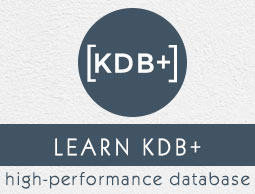
- KDB+ Tutorial
- KDB+ - Home
- KDB+ Architecture
- KDB+ - Overview
- KDB+ - Architecture
- Q Programming Language
- Q Programming Language
- Q Language - Type Casting
- Q Language - Temporal Data
- Q Language - Lists
- Q Language - Indexing
- Q Language - Dictionaries
- Q Language - Table
- Q Language - Verb & Adverbs
- Q Language - Joins
- Q Language - Functions
- Q Language - Built-in Functions
- Q Language - Queries
- Q - Inter-Process Communication
- Q - Message Handler (.Z Library)
- Q Advanced Topics
- Q Language - Attributes
- Q Language - Functional Queries
- Q Language - Table Arithmetic
- Q Language - Tables on Disk
- Q Language - Maintenance Functions
- KDB+ Useful Resources
- KDB+ - Quick Guide
- KDB+ - Useful Resources
- KDB+ - Discussion
Q Programming Language
Kdb+ comes with its built-in programming language that is known as q. It incorporates a superset of standard SQL which is extended for time-series analysis and offers many advantages over the standard version. Anyone familiar with SQL can learn q in a matter of days and be able to quickly write her own ad-hoc queries.
Starting the q Environment
To start using kdb+, you need to start the q session. There are three ways to start a q session −
Simply type c:/q/w32/q.exe on your run terminal.
Start the MS-DOS command terminal and type q.
Copy the q.exe file onto C:\Windows\System32 and on the run terminal, just type q.
Here we are assuming that you are working on a Windows platform.
Data Types
The following table provides a list of supported data types −
| Name | Example | Char | Type | Size |
|---|---|---|---|---|
| boolean | 1b | b | 1 | 1 |
| byte | 0xff | x | 4 | 1 |
| short | 23h | h | 5 | 2 |
| int | 23i | i | 6 | 4 |
| long | 23j | j | 7 | 8 |
| real | 2.3e | e | 8 | 4 |
| float | 2.3f | f | 9 | 8 |
| char | a | c | 10 | 1 |
| varchar | `ab | s | 11 | * |
| month | 2003.03m | m | 13 | 4 |
| date | 2015.03.17T18:01:40.134 | z | 15 | 8 |
| minute | 08:31 | u | 17 | 4 |
| second | 08:31:53 | v | 18 | 4 |
| time | 18:03:18.521 | t | 19 | 4 |
| enum | `u$`b, where u:`a`b | * | 20 | 4 |
Atom and List Formation
Atoms are single entities, e.g., a single number, a character or a symbol. In the above table (of different data types), all supported data types are atoms. A list is a sequence of atoms or other types including lists.
Passing an atom of any type to the monadic (i.e. single argument function) type function will return a negative value, i.e., n, whereas passing a simple list of those atoms to the type function will return a positive value n.
Example 1 Atom and List Formation
/ Note that the comments begin with a slash / and cause the parser / to ignore everything up to the end of the line. x: `mohan / `mohan is a symbol, assigned to a variable x type x / lets check the type of x -11h / -ve sign, because its single element. y: (`abc;`bca;`cab) / list of three symbols, y is the variable name. type y 11h / +ve sign, as it contain list of atoms (symbol). y1: (`abc`bca`cab) / another way of writing y, please note NO semicolon y2: (`$symbols may have interior blanks) / string to symbol conversion y[0] / return `abc y 0 / same as y[0], also returns `abc y 0 2 / returns `abc`cab, same as does y[0 2] z: (`abc; 10 20 30; (`a`b); 9.9 8.8 7.7) / List of different types, z 2 0 / returns (`a`b; `abc), z[2;0] / return `a. first element of z[2] x: Hello World! / list of character, a string x 4 0 / returns oH i.e. 4th and 0th(first) element